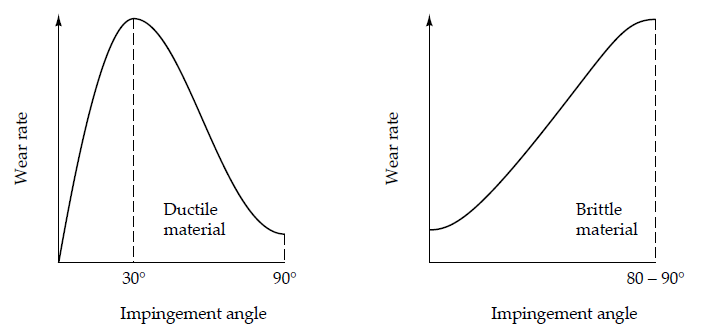I am currently working as a Postgraduate Researcher at the University of Leeds, where I am actively involved in research activities. Prior to this, I successfully completed my master's degree through the renowned Erasmus Mundus joint program, specializing in Tribology and Bachelor's degree in Mechanical Engineering from VTU in Belgaum, India. Further I handle the social media pages for Tribonet and I have my youtube channel Tribo Geek.
Erosive wear
Table of Contents
Erosive wear
Definition:
Erosive wear is the type of wear in which material degradation takes place due to the impact of external particles either solids or liquids on the surface of the material. The erosive wear can also be expressed as the destruction or the damage on the surface of the material when an object impinges at a very high velocity. The objects or the particles causing the erosive wear are called the eroding particle which largely influences the extent of the erosive wear. The various physical and chemical characteristics of the eroding particles affect the erosive wear and its formation. The mechanical components in the continuous influence of the external environments mostly experience erosive wear such as gas turbine blades of aircraft etc [1]. In Fig-1 the erosive wear on the impeller is shown.

Fig-1 Erosive wear on impeller on mine application
Mechanisms of the erosive wear:
The erosive wear formation on the surface is due to the impact of the eroding particle on the surface, the way how this eroding particle impact the surface plays an important role in the formation of the erosive wear. The impact angle of the eroding particle, the velocity of the impact, the material, and size the of the eroding particle are the influencing parameters on which the erosive mechanisms can be explained.
Abrasion by erosive wear:
This is caused when the eroding particle impacts the surface with a low angle causing the tearing of the surface of the material on which the eroding particle has impacted. The abrasion of the material takes place at the region of impact causing the crack on the surface leading to wear debris formation. This mechanism can be explained using Fig- 2.

Fig-2 Mechanism of abrasion by erosive wear [1].
Fatigue by erosive wear:
This is caused when the eroding particle impacts the surface of the material at a very high impact angle and low velocity. The region of the impact by the eroding particle has experienced stresses that are not suitable for the plastic deformation due to the low impact velocity of the eroding particle leading to surface fatigue. This mechanism is shown schematically in Fig- 3.

Fig-3 Mechanism of fatigue by erosive wear [1].
Plastic deformation by erosive wear:
This mechanism occurs when the impact of the eroding particle is at medium velocity and high impact angle. In the case of ductile materials, this impact causes plastic deformation on the surface forming the wear debris, however, in the case of brittle materials, there will be crack formation with large wear debris on the surface [2]. This mechanism is shown schematically in Fig- 4.

Fig-4 Mechanism of plastic deformation by erosive wear [1].
Surface melting by erosive wear:
This mechanism is caused when the eroding particle impacts the material’s surface at a very high velocity and high impact angle. This leads to the condition where the melting point of the material surface is lesser than the impact temperature leading to severe damage on the surface. This can be explained schematically in Fig- 5.

Fig-5 Mechanism of surface melting by erosive wear [1].
Macroscopic impact by erosive wear:
The macroscopic impact of erosive wear includes the melting of the material surface, superplastic flow, formation of large quantities of wear debris, etc. This is caused due to the large size of the eroding particle impacting the material surface, this mechanism is schematically shown in Fig- 6.

Fig-6 Mechanism of macroscopic impact by erosive wear [1].
Microscopic impact by erosive wear:
The microscopic impact of the erosive wear includes the disruption of the crystal structure lattice of the material surface. This leads to atomistic erosion as shown in Fig- 7.

Fig-7 Mechanism of microscopic impact by erosive wear [1].
Effect of Impact angle of the eroding particles:
The impact angle of the eroding materials plays an important role in influencing the extent of erosive wear and also it affects differently for different materials. The range of impact angles of the eroding particles is from 0° to 90°, where at 0° of impact there is no erosive wear on the surface. However, as the impact angle increases, say it’s 20° the extent of erosive wear is very severe for the softer material surface. The graphs of the impingement angle v/s wear rate for the ductile and brittle materials are shown in Fig- 8.

Fig-8 Graphs of the impingement angle v/s wear rate for the ductile and brittle materials [1].
The graph clearly shows that the high erosive wear rate of the ductile materials is at a low impingement angle. However in the case of the brittle materials the wear rate increase gradually with an increase in the impingement angle and is maximum at the higher impingement angle.
Effect of eroding wear parameters:
There are various parameters of the eroding particles affecting the erosive wear rate, such as the particle shape, size, hardness, and flux rate. These parameters are very important to understanding the extent of erosive wear rates.
- Particle shape: The shape of eroding particles is very important to be considered in understanding the erosive wear rates, however, this topic is very less researched. In particle shapes, it is known that the hard particles cause higher wear rates in compared to the soft particles. Also, it must be considered that the hardness factor is not the only feature to determine to extent of wear, if the particle is hard but relatively blunt then it is not desirable to cause erosive wear [3].
- Particle size: The size of the eroding particle is another important aspect to be considered for determining the extent of erosive wear. There are several sizes of the particles ranging from 8.75μm to 127μm in diameter causing erosive wear [4].
- Flux rate: The flux rate of the eroding particle is the mass of impacting materials per unit area in time. This is another important aspect to be considered for understanding the erosive wear rates, the flux rate of eroding particles is directly proportional to the erosive wear rate up to certain limiting values of wear [5].
Erosive wear in different environment mediums:
The effects of erosive wear differ in different environmental conditions for example air or liquid. In liquid medium, the erosive wear is characterized by the formation of slurry (eroding medium in liquid). This has very strong effects on the erosive wear rates and the properties like viscosity, density, turbulence, etc are the controlling factors macroscopically. On the microscopic scale the properties like a lubricant, and corrosivity effects the rate of erosive wear.
Erosive wear research:
There are many research that were conducted to understand erosive wear on a larger scale, the research was made to predict the erosive wear in different materials, solutions to prevent the erosive wear, etc. Also, many models were created in predicting the erosive wear of the materials Z. Zhang et.al., studied an artificial neural network model to predict the erosive wear on polymers [6]. The finite element model was developed by Yu-Fei Wang et.al., to study the erosive wear of ductile and brittle materials. Using this model, the effects of the impact angle and impact velocity particle penetration of the targets on the erosive wear were studied [7]. Pourahmadi et.al., studied the solid-fluid turbulent flow model to predict the erosive wear, the parameters such as the particle phase response with time, Reynolds number and concentration, and the turbulent characteristics of the fluids were considered [8].
Reference:
[1] Stachowiak, G.W. and Batchelor, A.W., 2013. Engineering tribology. Butterworth-heinemann.
[2] C.S. Yust and R.S. Crouse, Melting at Particle Impact Sites During Erosion of Ceramics, Wear, Vol. 51, 1978, pp. 193-196.
[3] J.E. Goodwin, W. Sage and G.P. Tilly, Study of Erosion by Solid Particles, Proc. Inst. Mech. Engrs., Vol. 184, 1969-1970, pp. 279-289.
[4] G.L. Sheldon and I. Finnie, On the Ductile Behaviour of Nominally Brittle Materials During Erosive Cutting, Transactions ASME, Vol. 88B, 1966, pp. 387-392.
[5] H. Busch, G. Hoff and G. Langben, Rain Erosion Properties of Materials, Phil. Trans. Roy. Soc., Series A, Vol. 260, 1966, pp. 168-178.
[6] Zhang, Z., Barkoula, N.M., Karger-Kocsis, J. and Friedrich, K., 2003. Artificial neural network predictions on erosive wear of polymers. Wear, 255(1-6), pp.708-713.
[7] Wang, Y.F. and Yang, Z.G., 2008. Finite element model of erosive wear on ductile and brittle materials. Wear, 265(5-6), pp.871-878.
[8] Pourahmadi, F. and Humphrey, J.A.C., 1983. Modeling solid-fluid turbulent flows with application to predicting erosive wear. PhysicoChemical Hydrodynamics, 4(3), pp.191-219.

Be the first to comment